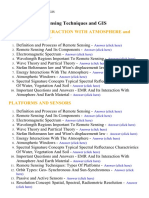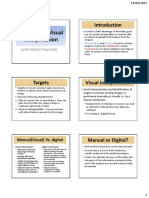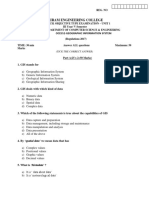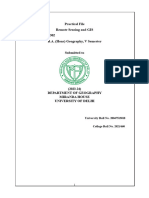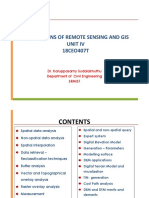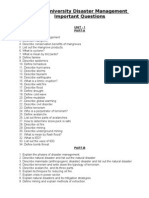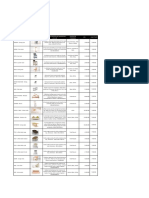Lecture Notes On Remote Sensing & Gis: IV B. Tech II Semester (JNTU (A) - R13)
Lecture Notes On Remote Sensing & Gis: IV B. Tech II Semester (JNTU (A) - R13)
Uploaded by
Kushana SaikirannCopyright:
Available Formats
Lecture Notes On Remote Sensing & Gis: IV B. Tech II Semester (JNTU (A) - R13)
Lecture Notes On Remote Sensing & Gis: IV B. Tech II Semester (JNTU (A) - R13)
Uploaded by
Kushana SaikirannOriginal Title
Copyright
Available Formats
Share this document
Did you find this document useful?
Is this content inappropriate?
Copyright:
Available Formats
Lecture Notes On Remote Sensing & Gis: IV B. Tech II Semester (JNTU (A) - R13)
Lecture Notes On Remote Sensing & Gis: IV B. Tech II Semester (JNTU (A) - R13)
Uploaded by
Kushana SaikirannCopyright:
Available Formats
REMOTE SENSING & GIS
LECTURE NOTES ON
REMOTE SENSING & GIS
IV B. Tech II semester (JNTU (A)-R13)
C.THEJASWINI VEENA
Assistant Professor
G.PULLAIAH COLLEGE OF ENGINEERING AND TECHNOLOGY
CIVIL ENGINEERING
BY C.THEJASWINI VEENA ASST. PROFESSOR Page 1
REMOTE SENSING & GIS
OBJECTIVES:
1. To understand the Photogrammetric techniques, concepts, components of Photogrammetry
OUTCOMES:
On completion of the course the students will have knowledge on
Principles of Photogrammetry
Analysis of RS and GIS data and interpreting the data for modeling applications
UNIT – I
INTRODUCTION TO PHOTOGRAMMETRY:
Principles& types of aerial photograph, geometry of vertical aerial photograph, Scale & Height
measurement on single vertical aerial photograph, Height measurement based on relief
displacement, Fundamentals of stereoscopy, fiducially points, parallax measurement using
fiducially line.
TEXT BOOKS:
1 Remote Sensing and GIS by B.Bhatta, Oxford University Press,New Delhi.
2 Fundamentals of remote sensing by gorge Joseph , Universities press, Hyderabad
BY C.THEJASWINI VEENA ASST. PROFESSOR Page 2
REMOTE SENSING & GIS
UNIT-1
Photogrammetry
Photogrammetry is the science of making measurements from photographs, especially for
recovering the exact positions of surface points. Moreover, it may be used to recover the
motion pathways of designated reference points located on any moving object, on its
components and in the immediately adjacent environment. Photogrammetry may employ high-
speed imaging and remote sensing in order to detect, measure and record complex 2-D and 3-D
motion fields. Photogrammetry feeds the measurements from remote sensing and the results
of imagery analysis into computational models in an attempt to successively estimate, with
increasing accuracy, the actual, 3-D relative motions within the researched field.
Its applications include satellite tracking of the relative positioning alterations in all Earth
environments (e.g. tectonic motions etc.), the research on the swimming of fish, of bird or
insect flight, other relative motion processes. The quantitative results of photogrammetry are
then used to guide and match the results of computational models of the natural systems, thus
helping to invalidate or confirm new theories, to design novel vehicles or new methods for
predicting or/and controlling the consequences of earthquakes, tsunamis, any other weather
types, or used to understand the flow of fluids next to solid structures and many other
processes.
Photogrammetry is as old as modern photography, can be dated to the mid-nineteenth century,
and its detection component has been emerging from radiolocation, multilateration and
radiometry while its 3-D positioning estimative component (based on modeling) employs
methods related to triangulation, trilateration and multidimensional scaling.
In the simplest example, the distance between two points that lie on a plane parallel to the
photographic image plane can be determined by measuring their distance on the image, if the
scale (s) of the image is known. This is done by multiplying the measured distance by 1/s.
Algorithms for photogrammetry typically attempt to minimize the sum of the squares of errors
over the coordinates and relative displacements of the reference points. This minimization is
known as bundle adjustment and is often performed using the Levenberg–Marquardt
algorithm.
Photogrammetry is the science of making measurements from photographs, especially for
recovering the exact positions of surface points. Moreover, it may be used to recover the
BY C.THEJASWINI VEENA ASST. PROFESSOR Page 3
REMOTE SENSING & GIS
motion pathways of designated reference points located on any moving object, on its
components and in the immediately adjacent environment. Photogrammetry may employ high-
speed imaging and remote sensing in order to detect, measure and record complex 2-D and 3-D
motion fields .Photogrammetry feeds the measurements from remote sensing and the results
of imagery analysis into computational models in an attempt to successively estimate, with
increasing accuracy, the actual, 3-D relative motions within the researched field.
Its applications include satellite tracking of the relative positioning alterations in all Earth
environments (e.g. tectonic motions etc.), the research on the swimming of fish, of bird or
insect flight, other relative motion processes. The quantitative results of photogrammetry are
then used to guide and match the results of computational models of the natural systems, thus
helping to invalidate or confirm new theories, to design novel vehicles or new methods for
predicting or/and controlling the consequences of earthquakes, tsunamis, any other weather
types, or used to understand the flow of fluids next to solid structures and many other
processes
Photogrammetry is as old as modern photography, can be dated to the mid-nineteenth century,
and its detection component has been emerging from radiolocation, multilateration and
radiometry while its 3-D positioning estimative component (based on modeling) employs
methods related to triangulation, trilateration and multidimensional scaling.
In the simplest example, the distance between two points that lie on a plane parallel to the
photographic image plane can be determined by measuring their distance on the image, if the
scale (s) of the image is known. This is done by multiplying the measured distance by 1/s.
Algorithms for photogrammetry typically attempt to minimize the sum of the squares of errors
over the coordinates and relative displacements of the reference points. This minimization is
known as bundle adjustment and is often performed using the Levenberg–Marquardt
algorithm.
The photogrammetry has been derived from three Greek words:
Photos: means light
Gramma: means something drawn or written
Metron: means to measure
This definition, over the years, has been enhanced to include interpretation as well as
measurement with photographs.
Definition:The art, science, and technology of obtaining reliable information about physical
objects and the environment through process of recording, measuring, and interpreting
photographic images and patterns of recorded radiant electromagnetic energy and
phenomenon .Originally photogrammetry was considered as the science of analysing only
photographs.
But now it also includes analysis of other records as well, such as radiated acoustical
energy patterns and magnetic phenomenon
Definition of photogrammetry includes two areas:
BY C.THEJASWINI VEENA ASST. PROFESSOR Page 4
REMOTE SENSING & GIS
(1) Metric: It involves making precise measurements from photos and other information
source to determine, in general, relative location of points.
Most common application: preparation of plannimetric and topographic maps.
(2) Interpretative: It involves recognition of objects and judging their significance through
careful and systematic analysis. It includes photographic interpretation which is the study of
photographic images. It also includes interpretation of images acquired in Remote sensing
using photographic images, MSS, Infrared, TIR, SLAR etc.
Aerial photography: It is the taking of photographs of the ground from an elevated/direct-
down position. Usually the camera is not supported by a ground-based structure.
Terrestrial photogrammetric: In this kind of photogrammetry, a camera is used in a
stationary position. The camera is positioned on an elevated level. The tilt and other
specifications of the camera are all controlled.
Photographic interpretation: It is “the act of examining photographic images for the purpose of
identifying objects and judging their significance” (Colwell, 1997). This mainly refers to its usage
in military aerial reconnaissance using photographs taken from reconnaissance aircraft.
Applications of photogrammetry: Photogrammetry has been used in several areas. The
following description gives an overview of various applications areas of photogrammetry
1)Geology: Structural geology, investigation of water resources, analysis of thermal patterns on
earth's surface, geomorphological studies including investigations of shore features.
2) Forestry: Timber inventories, cover maps, acreage studies
(3) Agriculture: Soil type, soil conservation, crop planting, crop disease, crop-acreage
(4) Design and construction: Data needed for site and route studies specifically for alternate
schemes for photogrammetry. Used in design and construction of dams, bridges, transmission
lines.
(5) Planning of cities and highways: New highway locations, detailed design of construction
contracts, planning of civic improvements.
(6) Cadastre: Cadastral problems such as determination of land lines for assessment of taxes.
Large scale cadastral maps are prepared for reapportionment of land.
(7) Environmental Studies: Land-use studies.
(8) Exploration: To identify and zero down to areas for various exploratory jobs such as oil or
mineral exploration.
(9) Military intelligence: Reconnaissance for deployment of forces, planning man oeuvres,
assessing effects of operation, initiating problems related to topography, terrain conditions or
works.
(10) Medicine and surgery: Stereoscopic measurements on human body, X-ray
photogrammetry in location of foreign material in body and location and examinations of
fractures and grooves, biostereometrics.
(11) Miscellaneous: Crime detection, traffic studies, oceanography, meteorological observation,
Architectural and archaeological surveys, contouring beef cattle for animal husbandry etc.
BY C.THEJASWINI VEENA ASST. PROFESSOR Page 5
REMOTE SENSING & GIS
Types of photogrammetry
Photogrammetry is divided into different categories according to the types of photographs or
sensing system used or the manner of their use as given below:
On the basis of orientation of camera axis:
i)Terrestrial or ground photogrammetry: When the photographs are obtained from the ground
station with camera axis horizontal or nearly horizontal
ii) Aerial photogrammetry: If the photographs are obtained from an airborne vehicle. The
photographs are called vertical if the camera axis is truly vertical or if the tilt of the camera axis
is less than 3o. If tilt is more than, the photographs are called oblique photographs.
On the basis of sensor system used: Following names are popularly used to indicate type of
sensor system used in recording imagery.
Radargrammetry: Radar sensor
X-ray photogrammetry: X-ray sensor
Hologrammetry: Holographs
Cine photogrammetry: motion pictures
Infrared or colour photogrammetry: infrared or colour photographs
On the basis of principle of recreating geometry
When single photographs are used with the stereoscopic effect, if any, it is
called monoscopic photogrammetry. If two overlapping photographs are used to generate three
dimensional views to create relief model, it is called stereophotogrammetry. It is the most
popular and widely used form of photogrammetry.
On the basis of procedure involved for reducing the data from photographs
Three types of photogrammetry are possible under this classification:
(a)Instrumental or analogue photogrammetry: It involves photogrammetric instruments to
carry out tasks.
(b) Semi-analytical or analytical: Analytical photogrammetry solves problems by establishing
mathematical relationship between coordinates on photographic image and real world objects.
Semi-analytical approach is hybrid approach using instrumental as well analytical principles.
(c) Digital Photogrammetry or softcopy photogrammetry: It uses digital image processing
principle and analytical photogrammetry tools to carry out photogrammetric operation on
digital imagery.
On the basis of platforms on which the sensor is mounted:
If the sensing system is spaceborne, it is called space photogrammetry, satellite
photogrammetry or extra-terrestrial photogrammetry. Out of various types of the
photogrammetry, the most commonly used forms are stereophotogrammetry utilizing a pair of
vertical aerial photographs (stereopair) or terrestrial photogrammetry using a terrestrial
stereopair.
BY C.THEJASWINI VEENA ASST. PROFESSOR Page 6
REMOTE SENSING & GIS
Classification of Photographs
The following paragraphs give details of classification of photographs used in different
applications
(1)On the basis of the alignment of optical axis
(a) Vertical : If optical axis of the camera is held in a vertical or nearly vertical position.
(b) Tilted : An unintentional and unavoidable inclination of the optical axis from vertical
produces a tilted photograph.
(c) Oblique : Photograph taken with the optical axis intentionally inclined to the vertical.
Following are different types of oblique photographs:
(i)High oblique: Oblique this contains the apparent horizon of the earth.
(ii)Low oblique: Apparent horizon does not appear.
(iii) Trimetrogon: Combination of a vertical and two oblique photographs in which the(central
photo is vertical and side ones are oblique. Mainly used for reconnaissance.
(iv) Convergent: A pair of low obliques taken in sequence along a flight line in such a manner
that both the photographs cover essentially the same area with their axes tilted at a fixed
inclination from the vertical in opposite directions in the direction of flight line so that the
forward exposure of the first station forms a stereo-pair with the backward exposure of the next
station.
Comparison of photographs:
Type of photo Vertical Low oblique High oblique
Coverage Least Less Greatest
Area Rectangular Trapezoidal Trapezoidal
Scale Uniform if flat Decreases from Decreases from
foreground to foreground to
background background
Difference Least Less Greatest
with map
Advantage Easiest to map - Economical and
illustrative
Characteristics Tilt < 3o Horizon does not Horizon appears
appear
(2). On the basis of the scale
(a) Small scale - 1 : 30000 to 1 : 250000, used for rigorous mapping of undeveloped terrain and
reconnaissance of vast areas.
(b) Medium scale - 1 : 5000 to 1 : 30000, used for reconnaissance, preliminary survey and
intelligent purpose.
(c) Large scale - 1 : 1000 to 1 : 5000, used for engineering survey, exploring mines.
BY C.THEJASWINI VEENA ASST. PROFESSOR Page 7
REMOTE SENSING & GIS
(3). On the basis of angle of coverage
The angle of coverage is defined as the angle, the diagonal of the negative format subtendsat
the real node of the lens of the apex angle of the cone of rays passing through the front nodal
point of the lens.
Name Coverage Format size (cm) Focal length
angle (cm)
Standard or 60o (i) 18 (i) 21
normal angle (ii) 23 (ii) 30
Wide angle 90o (i) 18 (i) 11.5
(ii) 23 (ii) 15
Super wide or 120o (i) 18 (i) 7
ultra wide angle (ii) 23 (ii) 8.8
Narrow angle < 60o - -
Aerial photographs showing various elements as defined
(a) Elements of vertical photograph (b) Section of imaging geometry showing various
elements
X-axis of photo: Line on photo between opposite collimation marks, which most nearly parallels
the flight direction.
Y-axis: Line normal to x-axis and join opposite collimation marks
BY C.THEJASWINI VEENA ASST. PROFESSOR Page 8
REMOTE SENSING & GIS
Principalpoint(o) The point where the perpendicular dropped from the front nodal point strikes
the photograph or the point in which camera axis pierces the image plane.
Camera axis It is a ray of light incident at front nodal point in the object space and at right
angles to the image plane.
Fiducial marks or collimation marks
Index marks usually four in number, rigidly connected with the camera lens through the camera
body and forming images on the photographs to which the position on the photograph can be
referred.
Photographs center The geometrical center of the photograph as defined by the intersection of
the lines joining the fiducial marks.
Format: It is the planar dimension of photograph (9" x 9", 7" x 7", 23 cm x 23 cm, 18 cm x 18
cm, 15 cm x 15 cm).
Photogram Photograph taken with a photogrammetric camera having fixed distance between
negative plane and lens and equipped with fiducial or collimating marks. For photograms the
bundle of rays on the object side at the moment of exposure can be reproduced. To achieve this
the following data known as the elements of interior orientation must be known:
Calibrated focal length
Lens distortion data
Location of the principal point with reference to the photograph center (normally these
two coincide)
Hence, a photogram is a photograph with known interior orientation
Difference between near vertical photographs and map
Production: Quickest possible and most economical method of obtaining information about
areas of interest. Boon for difficult areas. Enlarging and reducing easier in case of photographs
than maps.
Content: Map gives an abstract representation of surface with a selection from nearly infinite
number of features on ground. Photograph shows images of surface itself. Maps often represent
non-visible phenomenon this may make interpretation difficult for photograph. Special films like
color and infrared films can bring about special features of terrain.
Metric accuracy: Map is geometrically correct representation, photos are generally not. Maps
are orthogonal projections, photo is central projection. Map has same scale throughout photo
has variable scale. Bearing on photographs may not be true.
Training requirement: A little training and familiarity with the particular legend used in the map
enables proper use of map. Photo-interpretation requires special training although initially it
may appear quite simple as it gives a faithful representation of ground.
Definition of Stereoscopy
BY C.THEJASWINI VEENA ASST. PROFESSOR Page 9
REMOTE SENSING & GIS
Stereoscopy, sometimes called stereoscopic imaging, is a technique used to enable a three
dimensional effect, adding an illusion of depth to a flat image. In aerial photography, when two
photographs overlap or the same ground area is photographed from two separate position
forms a stereo-pair, used for three dimension viewing. Thus obtained a pair of stereoscopic
photographs or images can be viewed stereoscopically. A stereoscope facilitates the
stereoviewing process by looking at the left image with the left eye and the right image with the
right eye. It is based on Porro-Koppe’s Principle that the same light path can be generated in an
optical system if a light source is projected onto the image taken by an optical system.
Stereoscopic vision is constructed with a stereopair images using the relative orientation or tilt
at the time of photography. Stereo viewing allows the human brain to judge and perceive in
depth and volume. 3D representation of the earth’s surface resulting in the collection of the
geographic information with a greater accuracy compared to the monoscopic techniques.
Stereoscopic Vision
On our daily life we unconsciously perceive and measure depth using our eyes. This stereo
effect is possible because we have two eyes or binocular vision. The perception of depth
through binocular vision is referred to as stereoscopic viewing, which means viewing an object
from two different locations. Monoscopic or monocular vision refers to viewing surrounding
objects with only one eye. Depth is perceived primarily based on the relative sizes of objects,
shadow; distant objects appear smaller and behind closer objects. In stereoscopic vision,
objects are viewed with both eyes a little distant from each other (approximately 65 mm) helps
in viewing objects from two different positions and angles, thus a stereoscopic vision is
obtained. The angle between the lines of sight of two eyes with each object known as
parallactic angle helps our brain in determining the relative distances between objects. Lesser
the parallactic angle higher the objects depth. shows the human stereoscopic vision, parallactic
angle Øa > Øb, helps the brain automatically to estimate the differences (D a - Db) in depths
between the objects A and B. This concept of distance estimation in stereoscopic vision is
applied to view a pair of overlapping aerial photograph.
BY C.THEJASWINI VEENA ASST. PROFESSOR Page 10
REMOTE SENSING & GIS
BY C.THEJASWINI VEENA ASST. PROFESSOR Page 11
REMOTE SENSING & GIS
As an example, in two photographs overlap the same region, in which objects A, B and C are
situated at the same altitude and object Data different altitude, the four objects will be
observed in a different sequence in the two photographs a, b, d, c in the left photograph and a,
d, b, c in the right . In the same photograph, segments ab and bc are equal since they are at the
same altitude, but segments ad and dc are not
Perception of relief from two aerial photographs.
Stereoscopes
A stereoscope is used in conjunction with two aerial photographs taken from two different
positions of the same area, (known as a stereo-pair) to produce a 3-D image. There are two
types of stereoscopes: lens (or pocket) stereoscope and mirror stereoscope. Lens (or pocket)
stereoscope has a limited view and therefore restricts the area that can be inspected where as
in mirror stereoscope has wide view and enables a much larger area to be viewed on the stereo-
pair. The most obvious feature when using a stereoscope is the enhanced vertical relief. This
occurs because our eyes are only 65mm apart, but the air photos may be taken at 100s of
meters apart, hence the difference in exposures is far greater than the difference between our
eyes. Such an exaggeration also enables small features to become quite apparent and easily
viewed.
A stereoscopeconsists of a double optical system (lenses, mirrors, prisms, etc.) mounted on a
rigid frame supported on legs. In this way distance d is fixed and kept the focal distance. Thus
the optical system creates a virtual image at infinity and consequently stereoscopic vision is
obtained without eyestrain.
BY C.THEJASWINI VEENA ASST. PROFESSOR Page 12
REMOTE SENSING & GIS
Lens and mirror stereoscopes
A simple lens stereoscope is made up of two achromatic convex lenses. The focal length is equal
to d corresponding to the height of the stereoscope above the plane on which the stereo pair is
placed. The lens spacing (y) can allowed varying within 45 to 75 mm to accommodate individual
eye spacing. The disadvantage of lens stereoscope is that the features just underneath the lens
only are viewable but it has some magnification power. A mirror stereoscope comprises two
metalized mirrors, two prisms, two lenses and two eyepieces having little or no magnification
power. It enables viewing the optical part fixed on an arm and the photographic pairs are
arranged on two different planes. They facilitate analyses of several stereo pairs consecutively
without changing the arrangement in the whole overlap region compared to the lens
stereoscope.
Fiducial marks - Index marks, usually 4, at the center point of each side of an air negative or
photo. These are rigidly connected with the camera lens through the camera body—which
forms images on the negative. Usually are a hairline, across, or a half-arrowhead.
Principal Point - optical or geometric center of the photograph - the intersection between the
projection of the optical axis (i.e., the perpendicular to the center of the lens) and the ground.
Can be located by the intersection of lines between opposite side/corner fiducial marks.
Nadir - The nadir, also called vertical point or plumb point, is the image of the intersection
between the plumb line directly beneath the camera center at the time of exposure and the
ground. The nadir is important because relief displacement is radial from this point and is a
function of the distance of the displaced image from it. Unlike the principal point, there are no
marks on the photograph that permit to locate the nadir.
Isocenter - The point on the photo that falls on a line halfway between the principal point and
the Nadir point.
BY C.THEJASWINI VEENA ASST. PROFESSOR Page 13
You might also like
- Sco417 - Gis ExamDocument2 pagesSco417 - Gis ExamEICQ/00154/2020 SAMUEL MWANGI RUKWARO100% (1)
- Analytical & Digital PhotogrammetryDocument46 pagesAnalytical & Digital PhotogrammetryLuis Marquez Guillen100% (3)
- Lidar in MicrostationDocument39 pagesLidar in Microstationsandeep sati100% (1)
- Chapter 2 & 3-GIS Data and Database Management and Prcocessing SystemsDocument39 pagesChapter 2 & 3-GIS Data and Database Management and Prcocessing SystemsDani Ftwi80% (5)
- Final Examination Set1Document6 pagesFinal Examination Set1Chea Masangkay100% (1)
- Introduction To CartographyDocument47 pagesIntroduction To CartographyAnthony Mulenga100% (1)
- Remote SensingDocument18 pagesRemote SensingKonda Ramesh Reddy100% (6)
- What Is Destructive Distillation of CoalDocument2 pagesWhat Is Destructive Distillation of CoalKushana SaikirannNo ratings yet
- Supercentenarians: Supercentenarians: What Can We Learn From The Oldest People in The World?Document1 pageSupercentenarians: Supercentenarians: What Can We Learn From The Oldest People in The World?Catalin LoghinNo ratings yet
- Jsu PPT P2 2019 (Add Maths)Document1 pageJsu PPT P2 2019 (Add Maths)arephyzie100% (1)
- Basic Concepts of Remote SensingDocument43 pagesBasic Concepts of Remote SensingChinmoy Kurmi100% (1)
- Remote Sensing Techniques and GIS - Lecture Notes, Study Material and Important Questions, AnswersDocument5 pagesRemote Sensing Techniques and GIS - Lecture Notes, Study Material and Important Questions, AnswersM.V. TV100% (1)
- GIS Geographical Information SystemDocument45 pagesGIS Geographical Information SystemJames TheodoryNo ratings yet
- Module 3 Geographic Information SystemDocument31 pagesModule 3 Geographic Information SystemSujith NairNo ratings yet
- Model Questions GIS 2070Document1 pageModel Questions GIS 2070nijjjNo ratings yet
- Question Bank - Remote SensingDocument4 pagesQuestion Bank - Remote SensingNarasimhareddy Mmk100% (1)
- 02.answers GIS Can GiveDocument11 pages02.answers GIS Can GivesgrrscNo ratings yet
- Applications of Gps and Gis in Civil EngineeringDocument19 pagesApplications of Gps and Gis in Civil EngineeringVishal Patel33% (3)
- Elements of Visual InterpretationDocument4 pagesElements of Visual InterpretationJane Asasira100% (1)
- Multiple Choice QuestionsDocument2 pagesMultiple Choice QuestionsChinna Mgr50% (2)
- Remote Sensing and GisDocument17 pagesRemote Sensing and Gismd khajaNo ratings yet
- Geographic Information Systems: Lecture - IDocument29 pagesGeographic Information Systems: Lecture - ISanthosh JithendraNo ratings yet
- Application of GIS in Disaster ManagementDocument10 pagesApplication of GIS in Disaster ManagementPRAVIN ANNAMALAINo ratings yet
- Gis and Remote Sensing Question PaperDocument2 pagesGis and Remote Sensing Question PapermgsivasaiNo ratings yet
- GIS Introduction & Basics Seminar ReportDocument21 pagesGIS Introduction & Basics Seminar ReportRavindra Mathanker100% (7)
- Application and Functions of GISDocument14 pagesApplication and Functions of GISUmair ButtNo ratings yet
- GisDocument15 pagesGisRitapratim DasNo ratings yet
- Scale Measurement For Aerial PhotographyDocument13 pagesScale Measurement For Aerial PhotographySushant SawantNo ratings yet
- Gis Lecture Notes AllDocument53 pagesGis Lecture Notes AllJoshan PradhanNo ratings yet
- Gis Question BankDocument23 pagesGis Question BankVENKATESH100% (6)
- GIS and It's ComponentDocument16 pagesGIS and It's ComponentVijay Kumar KajleNo ratings yet
- IEQ-05 Geographic Information Systems NotesDocument16 pagesIEQ-05 Geographic Information Systems NotesIshani GuptaNo ratings yet
- Unit1 GisDocument5 pagesUnit1 GisVani RajasekharNo ratings yet
- Gis 309 HandoutDocument25 pagesGis 309 HandoutOlowu AbayomiNo ratings yet
- Gps Mcq's - Set-2Document4 pagesGps Mcq's - Set-2p vinodreddy100% (1)
- GISDocument26 pagesGISMd Hassan100% (4)
- Lecture 3 Data Entry and PreparationDocument29 pagesLecture 3 Data Entry and PreparationAddo MawuloloNo ratings yet
- GIS For Resource Assessment Management: Dr.R.Jaganathan Deartment of Geography University of Madras Chennai-600005Document79 pagesGIS For Resource Assessment Management: Dr.R.Jaganathan Deartment of Geography University of Madras Chennai-600005Selva KumarNo ratings yet
- OCE552 - GIS - Important QuestionsDocument2 pagesOCE552 - GIS - Important QuestionsBoopathi kNo ratings yet
- Geomatic Concepts: Sr. Dr. Mustaffa Bin Anjang AhmadDocument50 pagesGeomatic Concepts: Sr. Dr. Mustaffa Bin Anjang AhmadAfnan Hamimi100% (2)
- Remote Sensing FinalDocument4 pagesRemote Sensing Finalsubha18400% (2)
- Lecture 3-1 - Geometry of A Vertical Aerial PhotographDocument44 pagesLecture 3-1 - Geometry of A Vertical Aerial PhotographFaisel mohammedNo ratings yet
- GIS Question BankDocument3 pagesGIS Question Bankविपुल संतोष भोईर86% (7)
- Remote Sensing GISDocument28 pagesRemote Sensing GIShishamuddinohariNo ratings yet
- Chapter 5-Data Entry and PreparationDocument22 pagesChapter 5-Data Entry and PreparationDani Ftwi75% (4)
- Application of GISDocument97 pagesApplication of GISSujan Singh100% (1)
- Remote Sensing & GIS PracticalDocument90 pagesRemote Sensing & GIS Practicalchahat.2021.660No ratings yet
- Unit I Fundamentals of Gis 9Document53 pagesUnit I Fundamentals of Gis 9GokulNo ratings yet
- Geomatics Exit ExamDocument25 pagesGeomatics Exit ExamKidus SeleshiNo ratings yet
- GEOINFORMATICSDocument21 pagesGEOINFORMATICSAkhila Sunshine100% (1)
- 3 RS Remote Sensing LectureDocument60 pages3 RS Remote Sensing LectureAdityaNo ratings yet
- 64254-mt - Remote Sensing & GisDocument1 page64254-mt - Remote Sensing & GisSRINIVASA RAO GANTANo ratings yet
- Unit 4Document128 pagesUnit 4NIKHIL SAJI (RA1811027010052)No ratings yet
- Gis (Geographic Information System)Document27 pagesGis (Geographic Information System)አድሜ ልስልሱ100% (1)
- Photomaps and PhotomosaicsDocument14 pagesPhotomaps and PhotomosaicsKumar kumarapu100% (5)
- GIS Mid Sem Solution UpdatedDocument8 pagesGIS Mid Sem Solution UpdatedPallavi PatilNo ratings yet
- Khadar Abdisalam, M.SC University of Hargeisa: Introduction To Geographic Information Systems (GIS)Document29 pagesKhadar Abdisalam, M.SC University of Hargeisa: Introduction To Geographic Information Systems (GIS)abdikani abdilaahiNo ratings yet
- Anna University Disaster Management QUES BANKDocument4 pagesAnna University Disaster Management QUES BANKJunaid Pantheeran78% (9)
- Data Models Vector Data Model: Remote Sensing & Gis (18Cv651)Document12 pagesData Models Vector Data Model: Remote Sensing & Gis (18Cv651)Vinayaka DNo ratings yet
- SVG 102 - October2017 - Ver2Document45 pagesSVG 102 - October2017 - Ver2adedejidamilare2019No ratings yet
- RS and GIS - Lecture NotesDocument99 pagesRS and GIS - Lecture Notesmadhu.ammu112No ratings yet
- Chapter 4 - Photogrametric SurveyingDocument13 pagesChapter 4 - Photogrametric SurveyingSamuel GosayeNo ratings yet
- Remote Sensing and Gis: Lecture NotesDocument45 pagesRemote Sensing and Gis: Lecture Notesreddy reddyNo ratings yet
- Design of Support System and Stability Evaluation PDFDocument14 pagesDesign of Support System and Stability Evaluation PDFKushana SaikirannNo ratings yet
- Remote Sensing Sensors: GNR401 Dr. A. BhattacharyaDocument24 pagesRemote Sensing Sensors: GNR401 Dr. A. BhattacharyaKushana SaikirannNo ratings yet
- Eom3 PDFDocument24 pagesEom3 PDFKushana SaikirannNo ratings yet
- Interview SkillsDocument15 pagesInterview SkillsKushana SaikirannNo ratings yet
- Gas Monitoring and Testing in Underground Mines Using Wireless Technology IJERTV6IS010306 PDFDocument5 pagesGas Monitoring and Testing in Underground Mines Using Wireless Technology IJERTV6IS010306 PDFKushana SaikirannNo ratings yet
- Eom2 PDFDocument23 pagesEom2 PDFKushana SaikirannNo ratings yet
- Hydraulic Powerpack 2Document58 pagesHydraulic Powerpack 2Kushana Saikirann100% (2)
- Hydraulic PropDocument19 pagesHydraulic PropKushana Saikirann100% (1)
- GAS TESTING by N.C. KARMAKARDocument8 pagesGAS TESTING by N.C. KARMAKARKushana Saikirann100% (3)
- A Study On Influence of Density and Viscosity of Emulsion Explosive On Its Detonation VelocityDocument21 pagesA Study On Influence of Density and Viscosity of Emulsion Explosive On Its Detonation VelocityKushana SaikirannNo ratings yet
- Accidents Due To Fires in MinesDocument18 pagesAccidents Due To Fires in MinesKushana SaikirannNo ratings yet
- A RM 105 19 18 096 SourDocument5 pagesA RM 105 19 18 096 SourGuilherme RochaNo ratings yet
- Risk Factors Associated With Rural Water Supply Failure SseeDocument1 pageRisk Factors Associated With Rural Water Supply Failure SseeeerhuangaNo ratings yet
- Artemis User v8p4Document92 pagesArtemis User v8p4De Jesus, Alexander100% (1)
- SyllabusDocument3 pagesSyllabushassaneldibNo ratings yet
- Jump DiscontinuitiesDocument6 pagesJump DiscontinuitiesjeffconnorsNo ratings yet
- Thyroid Disease in Adults PDFDocument316 pagesThyroid Disease in Adults PDFAnonymous ZZCCXMoRosNo ratings yet
- 2014 Breast Surgery A Companion To SpecialistDocument99 pages2014 Breast Surgery A Companion To Specialiststeve shrimp100% (1)
- Project CHEMISTRYDocument9 pagesProject CHEMISTRYNishant NischayaNo ratings yet
- E03 Handbook Si Apd MPPCDocument25 pagesE03 Handbook Si Apd MPPCHuy OyNo ratings yet
- LGHB 2Document2 pagesLGHB 2sergio.sanchezcmiNo ratings yet
- AlvinT Price List 2016 - IDR - Okt2016 PDFDocument5 pagesAlvinT Price List 2016 - IDR - Okt2016 PDFDavid Epson Mayer0% (1)
- Math - Grade IXDocument11 pagesMath - Grade IXAisha MuneerNo ratings yet
- Begalthain - Fletchling SniperDocument8 pagesBegalthain - Fletchling SniperAlasdair GoudieNo ratings yet
- Industry-Leading, 2 - Generation NFC Controller: NXP NFC Controller PN544 For Mobile Phones and Portable EquipmentDocument4 pagesIndustry-Leading, 2 - Generation NFC Controller: NXP NFC Controller PN544 For Mobile Phones and Portable EquipmentambigrammiNo ratings yet
- The Boys StoryDocument7 pagesThe Boys StoryDaniel SousaNo ratings yet
- BHM 232 Food and Beverage Operations 4Document6 pagesBHM 232 Food and Beverage Operations 4Pankaj PathaniaNo ratings yet
- Lost SonsDocument11 pagesLost SonszlobmieNo ratings yet
- Jeenspsu21 PDFDocument13 pagesJeenspsu21 PDFShweta YadavNo ratings yet
- Raini Industries India Private Limited: Mba Summer InternshipDocument10 pagesRaini Industries India Private Limited: Mba Summer InternshipjijiNo ratings yet
- Unit Plan For WeeblyDocument21 pagesUnit Plan For Weeblyapi-452290042No ratings yet
- Intro Calapan City Pet HavenDocument14 pagesIntro Calapan City Pet HavenMark Brillo TorregozaNo ratings yet
- Modeling and Structural Analysis of Hovercraft AssemblyDocument10 pagesModeling and Structural Analysis of Hovercraft AssemblySunil Kumar P GNo ratings yet
- Level 1 Workbook Audioscript: Unit 1, Section 2, Exercise BDocument8 pagesLevel 1 Workbook Audioscript: Unit 1, Section 2, Exercise BAdamabella de CastilloNo ratings yet
- Why Is My Ipad Screen Distorted Screen When Touch - Google SearchDocument1 pageWhy Is My Ipad Screen Distorted Screen When Touch - Google SearchNani AyyuNo ratings yet
- 5 - Trichomonas VaginalisDocument16 pages5 - Trichomonas Vaginalisعبد الرحمن حامدNo ratings yet
- 0811-2 Concentrated Solar Energy - HelioDynamicsDocument20 pages0811-2 Concentrated Solar Energy - HelioDynamicsjames_stone4458No ratings yet
- Installation, Operation, Maintenance, and RepairDocument2 pagesInstallation, Operation, Maintenance, and Repair최승원No ratings yet
- đề 1Document7 pagesđề 1nguyendinhgialinhNo ratings yet











